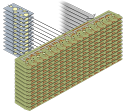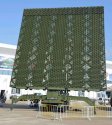You are right there. However, I think he meant receiver/exciter not LNA. The way I understood it, signals from LNAs are combined and sent to one of a small number of REX units.
What's he is saying is something like this.

This means the RX has to leave the module in analog form.
The thing is, not all AESA follow that diagram.
If you looked at the diagram I sent you, the signals are converted from analog to digital right in the module, and exits out of the module in digital form, and when its digital, its headed to the computing backend. Each channel has an D to A converter for the transmit and A to D converter for the receive. So at least for that design, it doesn't apply.
If you look at this module, it has four TX/RX channels, and the signals from four LNA might be combined in the same board. The interface to this module is digital, so anything coming in and out from the back are digital.

Other QTRM designs.


In contrast to the ones above, this module below has a single TX/RX channel. It only has a single 9 pin D shell connector for the transmit but has a coax for the receive. It gets the transmit data in digital but the receive data leaves the module in analog. This might be more what you are talking about. The circulator takes the RX and routes the signal right into where the coax output is. You can see it right there.

Now that I think about it, if an element has full transmit/receive, processing and waveform generation circuitry then it is a radar in itself. An AESA built out of such elements would constitute a multistatic radar. Don’t you agree?
Its not the point of being multistatic, in stealth, the design of the body is meant to not send the echoes back to the radiating source. So even if you are multistatic, these stations should not be in the same place as the transmitter. They need to be in a different location. Its not the principle of being multistatic, its the concept that the reciever must be in a different location.















